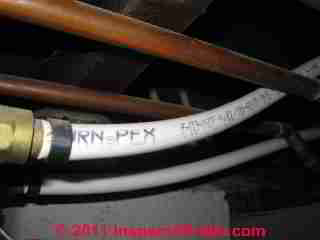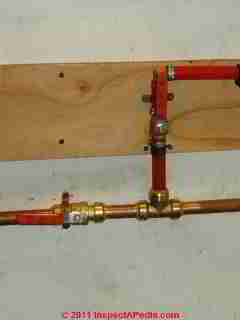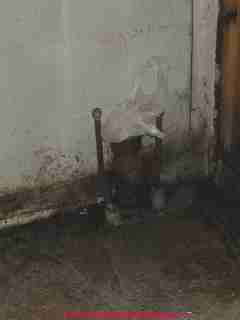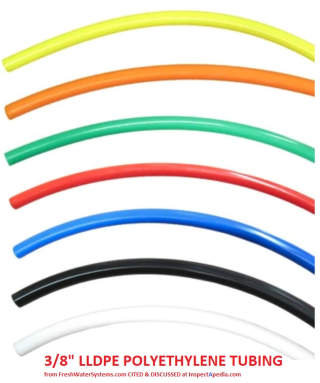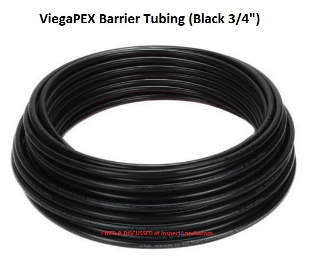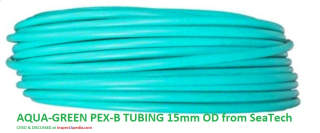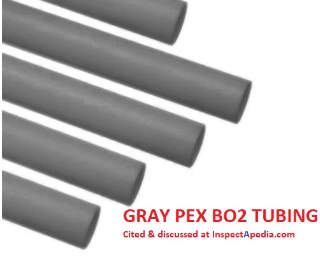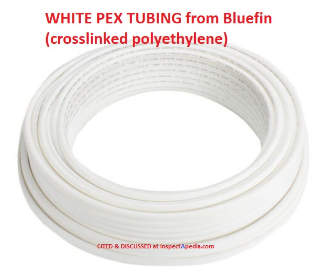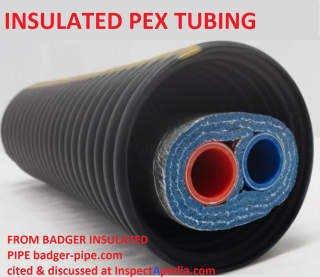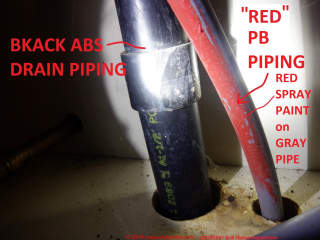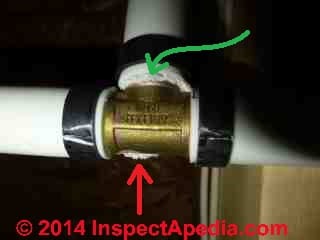 PEX Tubing & Piping
PEX Tubing & Piping
Cross-Linked Polyethylene PEX Piping Installation, Inspection, Safety
- POST a QUESTION or COMMENT about PEX polyethylene plastic supply and drain piping, gas piping, etc.
PEX cross linked polyethylene piping guide:
This article describes the properties of Pex Tubing or Piping, Cross-Linked Polyethylene (PEX). We discuss the uses of PEX tubing for water supply & in heating applications.
We describe the several differnt types of PEX tubing connector systems used including PEX crimp fittings, PEX compression fittings, PEX expander fittings, PEX Press-Fit connectors, and PEX Shark-Bite fittings and connectors.
We also discuss the ongoing debate of Pex versus Copper or other piping choices, with the pros and cons of each, and we include a literature review of and comment on the question is PEX tubing or piping safe to use or does it leach contaminants into our water supply. This article also includes the history of the development, use, & standards for PEX piping.
InspectAPedia tolerates no conflicts of interest. We have no relationship with advertisers, products, or services discussed at this website.
- Daniel Friedman, Publisher/Editor/Author - See WHO ARE WE?
Pex Tubing or Piping, Cross-Linked Polyethylene (PEX)

PEX and PB plastic pipe are used for water supply in buildings use mechanical fittings (crimp and compression type) and we have found some installers using PEX tubing in low temperature heating applications (see below). PEX piping is also referred to as "cross-linked polyethylene" piping or just "PEX".
Our photo (left) illustrates PEX water supply piping being installed in a New York home.
Photo courtesy Galow Homes.
[Click to enlarge any image]
Article Contents
Applications & Properties of PEX Piping
 Installing both building water supply piping and heating supply piping (and radiant heating) can be significantly faster using PEX tubing because of its ability to bend around turns, avoiding some elbows, 45's and other fittings.
Installing both building water supply piping and heating supply piping (and radiant heating) can be significantly faster using PEX tubing because of its ability to bend around turns, avoiding some elbows, 45's and other fittings.
PEX piping is used in both hot and cold water applications (see the blue and red colors below). By convention the builder uses blue PEX for cold water and red PEX for hot water supply piping lines.
Generally you will find PEX piping or tubing marked with the nominal pipe size, wall thickness, and pressure rating and other information (see the illustration just below).
Temperature and pressure ratings for PEX, according to Zurn Manufacturing's engineering specifications is 160 PSI at 73°F, 100 PSI at 180°F, and 80 PSI at 200°F.
Illustration of PEX tubing markings - courtesy Zurn Manufacturing (permission requested 12/2010). [Click any image or table to see an enlarged, detailed version.]
When installing PEX piping, care must be taken that the pipe does not contact heating ducts.
If the pipe freezes, it is less likely to burst than and copper piping. Also, most types of plastic water pipe tend to sag and should be well supported by hangers
Watch out: PEX plastic water piping should not be installed outdoors or exposed to sunlight for long periods. The red and blue PEX piping shown below (right) were delivering hot and cold water in a newly-constructed home. The larger black ABS plastic pipe is probably a drain line.
Watch out: do not use plastic piping nor any other type of piping in applications for which it was not intended, or the result could be dangerous. For example, do not use PEX tubing for LP or natural gas piping.
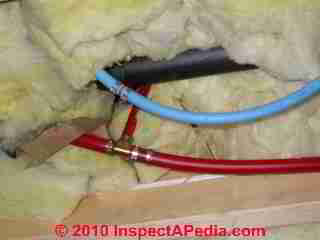 ...
... 
PEX Tubing Connectors: Types, Tools, Requirements
Watch out: a variety of patented PEX tubing push-fit and clamp connecting fittings (at least six types) and connector crimping tools are on the market.
You may not obtain a proper and secure PEX connection if you mix tubing connector fittings and crimping tools improperly.
We recommend choosing a specific connector type and crimping tool and using it consistently at a given plumbing installation.
See PEX BRASS CONNECTOR LEAKS for an update on field reports of de-zincification corrosion and leaks at brass PEX pipe connectors, elbows & tees.
Examples & Photographs of the various types of PEX fittings and the special tools used include:
- Clamp type PEX fittings (photo at left) using a brass connector and stainless steel clamp-rings (e.g. Hydro-Pex clamping tool). These connectors were in use in our PEX installation photograph above. Popular, easy to use.
Note in our PEX photo at left that on the cold water (blue) Tee fitting one of the clamp fittings remains to be completed. (Photo courtesy Galow Homes).
- Crimp type PEX fittings (photo above - Crimp type PEX fittings on white PEX tubing (from Zurn) in a Haddonfield New Jersey home) (e.g. Watts Radiant PEX cramping tool) using Hydro-Pex fittings.
The copper crimp rings are used with most PEX connectors.
- Compression type PEX fittings (photo at left) (radiant heating and other applications) uses three parts (connector, compression ring or ferrule, threaded nut) to connect PEX tubing to a radiant heating manifold.
Threaded nut and ferrule are used with an insert to prepare the tubing for connection to the manifold.
No special tools are needed and compression type PEX fittings work with standard and Pex tubing.
- Expander type PEX fittings (photo at left, Expander type PEX fittings in a Tivoli NY home), e.g. ProPEX brass connecting fittings and the ProPEX expander tool from Uponor (formerly Wirsbo PEX fittings).
The expander tool actually expands or "stretches" the PEX tubing to accept the connecting fitting. A ProPEX ring of larger diameter covers and completes the expanded fitting connection. Popular with professional plumbers.
Our PEX tubing photo (left) illustrates three PEX installation details: use of expander-type PEX fittings, and at the photo bottom (blue cold water piping) a protective sleeve or bushing at the floor joist penetration, and a steel nail plate to protect the tubing from puncture by ceiling drywall (to be installed).
Watch out: use only with PEX A-quality fittings. lower quality tubing will not make secure PEX connections with this method.
Watch Out: : in best construction practices all holes drilled through structural floor joists (shown at left) would be made in the center of the joist, not near the bottom as in our photo.
- Press-fit type PEX fittings from Wirsbo, Mr. PEX, and Viega. (do not assume you can mix fittings and tools among these three manufacturers). Use the Viega PEX press tool requires using Viega fittings, for example.
The Viega press PEX fittings are sold separately from the required stainless steel press PEX rings OR you can buy Viega pex press fittings that include the crimp ring already combined with the fitting.
When using the Viega method with the integrated fitting and crimp ring you'll need to look closely to assure that you have inserted the fitting fully into the tubing before crimping the sleeve using the Viega tool. Works with standard and Pex tubing.
- SharkBite PEX push-fit fittings (photo at left) - push-in fittings (also work with copper and CPVC). No tools or rings are required.
We used the SharkBite fitting shown at left to temporarily cut and discontinue active hot and cold water plumbing lines during a building renovation/addition project. The fittings avoided having to drain piping and solder end caps onto pipes that were later to be further cut back, excavated, and permanently capped below the slab. - SharkBite Plumbing Solutions, SharkBite USA
2300 Defoor Hills Rd. NW
Atlanta, GA 30318
USA Tel: 1-877-700-4242
SharkBite Canada 74 Alex Avenue Vaughan, Ontario, L4L 5X1 Canada, tel: 1-888-820-0120 retrieved 2020/01/19 original source: https://www.sharkbite.com/
SHARKBITE INSTALLATION GUIDE [PDF] (2018) Reliance Worldwide Corporation 2300 Defoor Hills Rd NW, Atlanta, GA 30318 Phone: 1-877-700-4242 Fax: 1-877-700-4280 rwc.com Reliance Worldwide Corporation (Canada) Inc. 74 Alex Avenue Vaughan, Ontario, L4L 5X1 Phone: 1-888-820-0120 Sales Inquiries: canadasales@rwc.com Orders: canadaorders@rwc.com retrieved 2019/08/13 original source: https://www.sharkbite.com/sites/g/files/rgohfh321/files/2018-05/SharkBite_Installation_Instructions_2018_WEB.p - PEX Tubing cutter - used to make a clean end-cut, e.g. Wirsbo (now Uponor) PEX cutter
See PEX BRASS CONNECTOR LEAKS for an update on field reports of de-zincification corrosion and leaks at brass PEX pipe connectors, elbows & tees.
Types of PEX Cross-Linked Polyethylene Tubing
Four methods of creating cross-linked polyethylene, each possibly imparting different properties to the PEX piping or tubing, include
- PEX-A or PE-Xa = using peroxide, developed by Engel, PAM, Frankische and others, this form of cross-linked polyethylene uses peroxides (oxygen atoms with an oxidation state of -1) to provide the highest level of molecular cross-linking at the atomic level in the plastic as the plastic polymer is formed.
PEX-A is the most-flexible and most kink-resistant of these forms of polyethylene tubing. - PEX-B or PE-Xb = using silane, developed by DOW Corning / Sioplas. Pex-B is also referred to as "steam" or "moisture" cross-linked polyethylene.
Unlike PEX-A, PEX-B cross-linking occurrs after the high-density polyethylene has been extruded into tubular form; the tubing is then passed through steam supplemented by silane (a catalyst) to form cross-links in the polymer tubing.
PEX-B is not expandable and has a lowered kink-resistance.
Excerpting from Conbraco, APOLLO PEX-B PIPE Submittal Sheet [PDF] Conbraco Industries, Inc., Matthews NC 28105 USA, Tel: 1-888-229-2874, Web: apolloflow.com
Excerpts:
PEX tubing is cross-linked, high-density polyethylene. It’s available in white, red, or blue colors for easy identification of hot and cold water lines. The silane method, also called the “moisture cure” method, results in PEX-B. In this method, cross-linking is performed in a secondary post-extrusion proce
ss, producing cross-links between a cross-linking agent. The process is accelerated with heat and moisture. The cross-linked bonds are formed through silanol condensation between two grafted vinyltrimethoxysilane (VTMS) units, connecting the polyethylene chains with C-C-Si-O-SiC-C bridges.1 PEX tubing is for use in hot and cold potable water distribution systems as well as hydronic radiant heating systems.
PEX tubing can also be used in “continuously recirculating” plumbing systems up to 140° F while maintaining chlorine resistance. The tubing may be installed in concrete, gypsum based lightweight concrete, sand, asphalt, in or under wood flooring, or behind wallboard or plaster.
Watch out: do not try to connect PEX-B by shoving its end over a fitting that would cause expansion of the tubing. Doing so will lead to a plumbing failure and leaks. - PEX-C or PE-Xc = using electronic irridiation. Unlike PEX-A, PEX-C cross-linked after the polymer material has been formed, but instead of using steam and silane (PEX-B process) PEX-C uses gamma radiation or an electron beam.
- PEX-D or PE-xd = using AZO (Gustavsberg-Lobonyl) - not currently in production
- Bean (2007)
Decoding PEX & Plastic Tubing Acronyms
- HIPS Polystyrene Tubing = High Impact Polystyrene Plastic Tubing: this is a high-impact-strength tubing, NOT-PEX tubing that is used in the food industry and other industrial applications.
- HDPE Polyethylene Tubing / PEX = High Density Polyethylene: posessing very good impact resistance, good rigidity, good heat distortion resistance at higher temperatures, a "fair" coefficient of thermal expansion, and a "fair" resistance to weathering when exposed outdoors.
- LDPE Polyethylene Tubing / PEX = Low Density Polyethyethylene Tubing, less costly, similar in properties to HDPE but less rigid.
- LLDPE Polyethylene Tubing / PEX = Linear Low Density Polyethylene: a form of polyethylene with increased flexibility, tensile strength, conformabilty, crack resistance. Described as imparting no odor or taste to water passing through the tubing.
- PETG Polyethylene Tubing / PEX = Polyethylene Terephthalate Glycol plastic tubing: this is a chemical-resistant tubing (does not tolerate outdoor exposure)
- POLYPROPYLENE (plastic) tubing: this is a lightweight NOT-PEX tubing that is heat resistant, used in automotivbe, food and beverage, automotive, appliances and other applications.
Example Colors of PEX Polyethylene Pipe / Tubing
Below the rainbow of 3/8" OD LLDPE polytethylene tubing is provided by FreshWater Systems.
In these examaple Pex tubing color choice photos, we show that PEX tubing or pipe is produced in a range of colors that include at least
Black, Blue, Gray, Green, Orange, Red, Yellow, White and also not quite "clear" but translucent such as Uponor TrffPEX SDR9 PEX-A tubing shown just below.
Below: Black Viega PEX tubing [Click to enlarge any image]
Below: Blue & Red PEX tubing installed in a New York home.
Below: two examples of green colored PEX and PEX-B tubing from SeaTech & Zoro.
The SeaTech PEX cross-linked polytethylene tubing shown here is manufacgtured in a range of sizes from 3/8" CTS (1/2" OD) to 1" CTS (9/8" OD), also 15mm and 22mm OD, and is rated for 160 psi and 80º F @ 100 psi OR at 72º F @ 160 psi.
The Zoro polyethylene pipe example is 1/4" OD, 5/32" ID, 3/64" wall thickness, 2" tubing bend radius, and rated for -50 D°F to 140°F.
Above: Gray Pex B02 tubing
Above: two examples of white PEX
Keep in mind that PEX or other types of plastic pipe or tubing may be installed but "disguised" by other coverings such as pipe insulation.
Below: an example of factory-insulated PEX tubing provided by Badger Insulated Pipe.
Badger describes this product: This listing is for Insulated Pipe used for Outdoor Wood Furnaces/Boilers, Geo Thermal, Solar Heating or anywhere you need to transfer heated or chilled fluids. - retrieved 2019/11/08, original source: Badger Insulated Pipe W8359 State Rd 82 Mauston, WI 53948 1-800-571-7002 rsd@badgerpipe.com
Standards, Listings and Approvals for PEX Plumbing Systems
The following standards and building codes list at least some elements of PEX plumbing systems.
- ANSI/NSF Standard 14 (NSF International)
- ANSI/NSF Standard 61
- ASTM F876 (American Society for Testing & Materials)
- ASTM F877
- ASTM F1807
- CAN/CSA B137.5 (Canadian Standards Association)
- California Plumbing Code - 2010
- IPC (International Plumbing Code)
- IRC (International Residential Code)
- UPC (Uniform Plumbing and Mechanical Code)
- U.S. State & Local Regulations or Canadian Provincial or Local Regulations
Pex Tubing / Plumbing use History & Dates
Watch out: is this "red" plastic water piping PEX? No it is red-painted Polytbutylene pipe, discussed in detail
In the United States the use of PEX tubing in residential buildings for water supply & heating piping has been approved for use in all fifty states and in Canada in all of the provinces.
- 1933: (accidental) discovery of polyethylene following an explosion at Imperial Chemial Industries in England
- 1939: pilot plant production of polyethylene in the U.S.
- 1940's: BASF in Germany experiments with polyethylene tubing
- 1950: beginning research on cross-linked polyethylene plastics.
- 1954: Hoechst experiments with Hoestlan high density polyethylene & predicts very long life of the tubing (more than50 years). Early tubing needed further development to withstand high temperatures.
- 1965: Engel patents an economical process for successfully cross-linking polyethylene
- 1967: First licensed use of the Engel patent to produce Vernetzes polyethylene i.e. PEX
- 1970's: PEX formulation improved by Lenman, Agren et als.
- 1975: Golan produces PEX-a & PEX-c later sold to American & Canadian interests
- 1975-85: standards for PEX piping developed by Stufen, Liedelt, Stagge & Seydel et. als.
- 1980: PEX piping introduced for use in the United States & Canada. DIN 4726 created limiting Oxygen gas transmission rate, a factor in tubing success. (Oxygen permeation / outgassing created problems in hot water heating applicatyions.)
- 1984: ASTM F876/877 Lenman published for PEX Tubing
- 1984: oxygen-related boiler corrosion problems reported associated with "non-barriered" pipe used in heating systems leads to continued research on the oxygen diffusion problem
- Latter 1980's: PEX tubing radiant heat applications developing in North America and elsewhere
- 1987: DIN 4726 standard finalized.
- 1989: CSA 137.5 for PEX published by Lenman
- 1990-2007: production of PEX a,b,c (various methods of producing cross-linked polyethylene tubing), PEX-AI-PEX, and PE-RT tubing.
- 1995: begin use of IPEX-manufactured Kitec fittings later found to fail & leak
- 15 May 1999: beginning of period of defective Plumb-Pex defective component installations in North America - for class action settlement purposes
See details at PlumbPex® PEX LEAKS & LAWSUIT - 1 January 2005: begin production of NIBCO PEX products later found to be defective.
- 2005: IPEX recalls Kitec®, or Kyetec brand of brass plumbing fittings
- 2009: California approved PEX for use in all homes.
- 2007: California, one of the last adopters, did not approve the use of PEX (cross-linked polyethylene tubing) for household plumbing until 2007 (on a case by case basis)
- 31 March 2012 - end date for filing claims re: Court ordered homeowner notification program for defective Plumb-PEX components
- 31 December 2012 - end date for production of defective NIBCO PEX Tubing, fittings, and clamps, produced since 1 January 2005.
- 22 September 2013: ending date for filing claims for the Court ordered homeowner notification program for defective Plumb-PEX components
- 26 October 2018 NIBCO PEX Class Action Lawsuit [PDF] opened, petaining to owners or occupants of NIBCO PEX plumbed buildings betweeen 1 January 2005 and the date of the class action suit; (A closure date is not yet evident - Ed.)
More information: NIBCO PEX SETTLEMENT CLAIMS WEBSITE at https://www.pexsystemsettlement.com/ providing claims forms, contact information and other information for consumers.
KIMBERLY COLE, et al, on behalf of themselves and all others similarly situated, [PDF] Plaintiffs, vs. NIBCO, Inc., Defendant UNITED STATES DISTRICT COURT FOR THE DISTRICT OF NEW JERSEY Civil Action No. 13-cv-7871 (FLW)(TJB)]
See also PEX BRASS CONNECTOR LEAKS - web article
PEX Pipes vs Copper Piping: which is preferred?
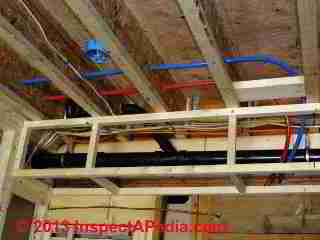 Reader Question: Pex vs. Copper Water Supply Piping - which should I use?
Reader Question: Pex vs. Copper Water Supply Piping - which should I use?
Question: my daughter is doing extensive renovations on her house and the question has come up whether to use PEX or copper in the plumbing.
I did a google search and the informations is conflicted; see below
. [We read & also expanded the writer's original four web link citations in the article below - Ed.] Do you have knowledge of, and opinions about, this controversy? Any thoughts would be helpful. Thanks. Elisha Fisch, New York 2/17/2013
Reply:
Elisha I've moved this discussion on Pex pipes vs copper pipes to its own article at
PLASTIC vs. COPPER PIPES in BUILDINGS
We will continue to monitor the PEX health and contamination question and will update here. Contact Us by email to send field reports or to report on new studies.
Copper Water Supply Piping
The same PLASTIC vs. COPPER article above lists propertie of copper water supply pipes when used in buildings and compares copper pipe performance with that of plastic.
A bottom line opinion is that each plumbing material has its own vulnerabilities as well as advantages & disadvantages.
We discuss types of copper piping and their intended uses and copper fittings beginning
at COPPER PIPING in BUILDINGS.
Plumb-PEX Plumbing System Class Action Settlement - PEX piping leaks
In March 2012 people who own or previously owned a building where Plumb-PEX plumbing components were installed are notified of a proposed class action settlement involving Radiant Technology, Inc. and Uponor, Inc who sold Plumb-PEX insert fittings and stainless steel PEX tubing clamps.
Details about this PEX plastic piping failure are now at PlumbPex® PEX LEAKS & LAWSUIT
Also see PEX vs. COPPER Water Supply Piping - health & other questions
Kitec Brass Fitting & Related IPEX Plastic Pipe Leaks: Class Action Settlement
The Kitec system was a collection of brass plumbing connectors intended for use with PEX type plastic piping. Kitec, also in some sources spelled Kyetec is a brand of brass plumbing fitting that was recalled in 2005 by its manufacturer, IPEX, due to its tendency to quickly corrode. - Wikipedia [30]
Kitec plastic pipe and fittings has agreed to settle class-action suits in the United States and Canada for $125 million. The piping system that is the subject of this action was used in roughly 292,000 U.S. and Canadian homes beginning in 1995.
Details about the Kitec plastic class action suit are given in a link just below.
Question: is PEX the same as Kitec® ?
Is PEX the same as Kitec? How does one tell distinguish between Kitec and PEX? - Anon
Reply: Kitec was an individual brand of PEX pipe subject of a class action settlement
Anon,
PEX (cross-linked polyethylene piping) is a general term for a type of plastic piping used in water supply, heating, and other applications.
Kitec® is a specific brand of PEX tubing that was subject of a class action settlement with an end-date for filing claims of 31 March 2012.
- Details about plastic pipe leaks by pipe type & brand are in this topic home page:
PLASTIC PIPE LEAK CAUSES - Kitek® PLASTIC PIPE LEAKS, CLASS ACTION SETTLEMENT discussion is found within that article.
- PEX PIPING INFORMATION (this page) gives details about PEX across the product range
- Information about all types of plastic piping used in buildings starts
at PLASTIC PIPING ABS CPVC PB PEX PPR PVC.
Pex De-zincification Update & Research: field failure photographs of Brass PEX Pipe Fitting Corrosion & Leaks
[Click to enlarge any image]
Above left: brass tee corrosion appearing both on the Tee-fitting body (red arrow) and around the end of the PEX tubing (green arrow) on water piping in a 2009 home.
Details about corrosion, leaks, & possible dezincification problems at brass connectors used in PEX piping systems are
PEX Piping vs Drinking Water Contamination & Pex Piping Installation Guides
- Kelley, Keven M., Alexandra C. Stenson, Rajarashi Dey, and Andrew J. Whelton. "Release of drinking water contaminants and odor impacts caused by green building cross-linked polyethylene (PEX) plumbing systems." Water research 67 (2014): 19-32.
- HUD, PPFA, DESIGN GUIDE for RESIDENTIAL PEX WATER SUPPLY PLUMBING SYSTEMS [PDF] (2006) HUD, U.S. Department of Housing & Urban Development,
Plastics Pipe Institute, Inc (PPI) 105 Decker Court Suite 825 Irving, TX 75062 www.plasticpipe.org and Plastic Pipe and Fittings Association (PPFA) 800 Roosevelt Road, Bldg. C, Ste. 312 Glen Ellyn, IL 60137 www.ppfahome.org and
Partnership for Advancing Technology in Housing 451 7th Street, SW Washington, DC 20410 www.pathnet.org and NAHB Research Center, Inc. 400 Prince George’s Boulevard Upper Marlboro, MD 20774 www.nahbrc.org retrieved 2019/09/20 or\iginal source: https://www.huduser.gov/portal/publications/pex_design_guide.pdf
See Figure 11.2 – Snow and Ice Melt Piping for a Driveway p. 92 - HUD PEX DESIGN GUIDE [PDF] U.S. HUD - older version of the above
- MacNevin, Lance, P.Eng., DESIGN AND INSTALLATION OF HYDRONIC SNOW AND ICE MELTING (SIM) SYSTEMS TO OPTIMIZE PERFORMANCE AND EFFICIENCY [PDF] Plastics Pipe Institute, Inc (PPI) 105 Decker Court Suite 825 Irving, TX 75062 www.plasticpipe.org retrieved 2019/09/20, original source: https://www.modernhydronicssummit.com/wp-content/uploads/sites/3/2017/09/MacNevin-Summit-2017.pdf
- PEX TUBING TECHNICAL SPECIFICATIONS [PDF] PEX Universe.com (Sales of PEX tubing) Tel: 800-818-3201 original source: https://www.pexuniverse.com/pex-tubing-technical-specs
- Plastic Pipe & Fittings Assoc. PEX INSTALLATION HANDBOOK [PDF] (2016) Plastic Pipe & Fittings Assoc. , Plastic Pipe and Fittings Association
800 Roosevelt Road
Building C, Suite 312
Glen Ellyn, IL 60137
www.ppfahome.org
Cross-linked Polyethylene (PEX) Hot- and Cold-Water Distribution systems And Service Lines
Excerpts:
This manual contains information on the installation of Cross-linked Polyethylene (PEX) tubing for hot- and cold-water distribution systems in residential and light commercial installations using tubing up to 2 inch diameter.
Information in this manual shall not be separated as it is often interrelated. Consult local codes for additional installation requirements.
For additional information contact: Local officials having jurisdiction (for codes) Manufacturer (for specific product information) PPFA (for general installation instructions) Plastics Pipe Institute (PPI)
- WattsRadiant, RADIANT PEX® INSTALLATION MANUAL [PDF] (2017) Watts Radiant, USA: Tel: (800) 276-2419 • Fax: (417) 864-8161 • WattsRadiant.com
Canada: Tel: (905) 332-4090 • Fax: (905) 332-7068 • Watts.ca Latin America: Tel: (52) 81-1001-8600 • Fax: (52) 81-8000-7091 • WattsRadiant.com retrieved 2019/09/20 original source: http://media.wattswater.com/IOM-WR-PAP-PEX-PEXAL-PERT.pdf - Zurn, ZURN PEX PLUMBING INSTALLATION GUIDE [PDF] (2010), ZURN PEX®, Inc.
Highway 11 EAST,
Commerce, TX, U.S.A. 75428
USA, Tel: 1-800-872-7277 Web: www.zurn.com
Canada: ZURN Industries Ltd., 3544 Nashua Drive, Mississauga, Ontario, Canada L4V 1L2 Tel: 905-405-8272 retrieved 2021/07/01 original source: https://api.ferguson.com/dar-step-service/Query?ASSET_ID=927224&USE_TYPE=INSTALLATION&PRODUCT_ID=3784258
...
Reader Comments, Questions & Answers About The Article Above
Below you will find questions and answers previously posted on this page at its page bottom reader comment box.
Reader Q&A - also see RECOMMENDED ARTICLES & FAQs
On 2019-09-20 by (mod) - what size PEX for step and sidewalk de-icer / snow melt systems?
Bill
Please see your question and our detailed answer at
On 2019-09-19 by Bill
I have a radiant floor heating system for two rooms with 1/2" PEX that works fine. When I put it in, I used a manifold with an extra space in case I wanted to add a circuit.
We are going to repour front steps and sidewalk to the driveway and I thought that that would be a good use of my additional circuit. But I have read that any outdoor application should use 3/4" PEX instead of 1/2".
Can I mix have two circuits with 1/2" PEX and one with 3/4"? Can I just use 1/2" for the outdoor steps and sidewalk and expect it to keep the snow off? (I live in SE Michigan.)
On 2019-06-18 by (mod) - Wirsbo aquaPEX 1006 3/4 " piping leaks
RE-posting from private email:
Anonymous said:
Inspected a home with Wirsbo aquaPEX 1006 3/4 " piping.
My plumber claims the pipe fails and leaks at weak points and advised me to tell my client that replacement is needed
Was wondering if you have any hard facts and what your opinion is.
Moderator reply: Wirsbo, now Uponor PEX pipe & fitting failure report
Your plumber is correct, Anon, that there have been PEX piping leaks at some fittings. Leaks have been traced to
After reading up on PEX piping above on this page you will want to review
Details at PEX BRASS CONNECTOR LEAKS
There we show photos of old, leaky UPONOR TuffPEX (previously Wisbro some mis-spell as Wirsbo) seals in a PEX piping system as reported by an InspectApedia.com reader and we include an illustration of the newer, more-reliable insert seals for PEX connector that connect PEX tubing to plumbing fixtures.
On 2016-01-29 2 by Anonymous should you cross PEX pipes over one another?
should you cross the pipes over one another?
On 2015-12-26 by (mod) -
Not that I know of, Anon, but you can certainly ask your local building department if they have such restrictions.
On 2015-12-25 by Anonymous
hi. i want to know , is it against the building code to install pex water pipe in the restaurants ?
Question: installing PEX in concrete
(July 17, 2014) Anonymous said:
When putting pex in concrete do you need to pressurize the system before you pour the concrete?
Reply:
While I can't cite an authoritative reference, certainly I've never seen a system pressurized before installation.
I do see that the pex tubing is capped and supported above the slab to keep it acessible and clean at its connection points.
...
Continue reading at PEX BRASS CONNECTOR LEAKS (discussing de-zincification and leaks at PEX connectors) or select a topic from the closely-related articles below, or see the complete ARTICLE INDEX.
Or see these
Recommended Articles
- CARPETING IMPACT on RADIANT HEAT FLOOR
- DRIVEWAY & WALK DE-ICING SYSTEMS
- PIPING in BUILDINGS, CLOGS, LEAKS, TYPES - home
- PLASTIC PIPE LEAK CAUSES
- PLASTIC PIPING ABS CPVC PB PEX PPR PVC - home
- ABS PLASTIC PIPE
- CPVC & PVC PLASTIC PIPING
- JM Eagle® DEFECTIVE PVC PolyVinyl Chloride PIPING LAWSUIT
- Kitek® PLASTIC PIPELEAKS & LAWSUIT
- PB POLYBUTYLENE (PB) PIPES
- PB PIPE FAILURE CLAIMS
- PEX PIPING INFORMATION
- PEX vs. COPPER PIPING, SAFETY
- PEX BRASS CONNECTOR LEAKS
- PEX CONNECTIONS to WATER HEATERS
- PLASTIC PIPE LEAK CAUSES
- PLASTIC vs. COPPER PIPES in BUILDINGS
- PlumbPex® PEX LEAKS & LAWSUIT
- PVC & CPVC PIPE INSTALLATION STEPS
- PVC & CPVC PIPE GLUING SET & CURE TIMES
- PLASTIC PIPE PRESSURE LIMITS
- PLASTIC PLEXVENT ULTRAVENT RECALL
- RADIANT HEAT - home
- WATER SUPPLY PIPE DIAMETER vs FLOW - PEX ID is smaller than Copper Pipe ID
Suggested citation for this web page
PEX PIPING INFORMATION at InspectApedia.com - online encyclopedia of building & environmental inspection, testing, diagnosis, repair, & problem prevention advice.
Or see this
INDEX to RELATED ARTICLES: ARTICLE INDEX to PLUMBING SYSTEMS
Or use the SEARCH BOX found below to Ask a Question or Search InspectApedia
Ask a Question or Search InspectApedia
Try the search box just below, or if you prefer, post a question or comment in the Comments box below and we will respond promptly.
Search the InspectApedia website
Note: appearance of your Comment below may be delayed: if your comment contains an image, photograph, web link, or text that looks to the software as if it might be a web link, your posting will appear after it has been approved by a moderator. Apologies for the delay.
Only one image can be added per comment but you can post as many comments, and therefore images, as you like.
You will not receive a notification when a response to your question has been posted.
Please bookmark this page to make it easy for you to check back for our response.
IF above you see "Comment Form is loading comments..." then COMMENT BOX - countable.ca / bawkbox.com IS NOT WORKING.
In any case you are welcome to send an email directly to us at InspectApedia.com at editor@inspectApedia.com
We'll reply to you directly. Please help us help you by noting, in your email, the URL of the InspectApedia page where you wanted to comment.
Citations & References
In addition to any citations in the article above, a full list is available on request.
- Bean, Robert, "The History and Influence of PEX Pipe on Indoor Environmental Quality", healthyheating online article (2007), Email: info@healthyheating.com, website: www.healthyheating.com, retrieve 6/25/2014, original source: http://www.healthyheating.com/History_of_Pex.htm
- Bean, Robert, Bjarne W. Olesen, Ph.D., Kwang Woo Kim, Arch.D., "History of Radiant Heating & Cooling Systems", ASHRAE Journal, January 2010, Website: ASHRAE.org
- Eric Galow, Galow Homes, Lagrangeville, NY. Mr. Galow can be reached by email: ericgalow@gmail.com or by telephone: 914-474-6613. Mr. Galow specializes in residential construction including both new homes and repairs, renovations, and additions.
- Mark Cramer Inspection Services Mark Cramer, Tampa Florida, Mr. Cramer is a past president of ASHI, the American Society of Home Inspectors and is a Florida home inspector and home inspection educator. Mr. Cramer serves on the ASHI Home Inspection Standards. Contact Mark Cramer at: 727-595-4211 mark@BestTampaInspector.com
- John Cranor [Website: /www.house-whisperer.com ] is an ASHI member and a home inspector (The House Whisperer) is located in Glen Allen, VA 23060. He is also a contributor to InspectApedia.com in several technical areas such as plumbing and appliances (dryer vents). Contact Mr. Cranor at 804-873-8534 or by Email: johncranor@verizon.net
- [3] PB (polybutylene with mechanical fittings) Piping leaks: especially in mobile homes and in the U.S. South, for example trailers and double-wides throughout Florida that were piped with this material - per M Cramer. See "Polybutylene Piping: Time Bomb?" Daniel Friedman, Journal of Light Construction, August 1996 [Technical Q&A] .
- [4] ABS Plastic Pipe: "All Black -hit," defective black ABS plastic waste pipe manufactured in the mid 1980's failed by cracking. Additional information: www.abspipes.com
- [5] Polybutylene Plumbing (plastic pipes): gray plastic water supply piping cracked, leaked, and resulted in a class action and settlement.
- [6] ABS Plastic Drain/Waste/Vent (DWV) pipe failures: reported for Centaur, Phoenix, Polaris, Gable, and Spartan pipe mfgs. for pipe made between 1985 and 1988. CPSC Hot Line: 800-638-8270 or ABS Drain Leaks/Failures-Class Action Settlement COX settlement through Shell Oil set up by a contractor involved in the settlement Plumbing Failures: Spencer Class settlement. 10% of replacement cost/damages, only for acetal (plastic)fittings Polybutylene plumbing lawsuit proposed settlement-old site
- COX settlement through Shell Oil set up by a contractor involved in the settlement
- Additional information: ABS PLASTIC PIPE FAILURES
- Eric Galow, Galow Homes, Lagrangeville, NY. Mr. Galow can be reached by email: ericgalow@gmail.com or by telephone: 914-474-6613. Mr. Galow specializes in residential construction including both new homes and repairs, renovations, and additions.
- [7] PB Technology Center (information about PB Pipes) Tel: 800-338-7732, also see the 1990 PB Pipe recommendations published by the Polybutylene Product Line Committee of the Plastic Pipe and Fittings Association.
- Polybutylene Plumbing Failures: Spencer Class settlement, Web: spencerclass.com, 10% of replacement cost/damages, only for acetal (plastic)fittings
- [8] Polybutylene plumbing info at U. Arizona
- [9] Polybutylene piping lawsuit settlement website
- [10] Polybutylene plumbing lawsuit proposed settlement-old site
- [11] plumbing911.com/poly/ Polybutylene Plumbing Failures , Lots of Info about, but slow-loading busy site - now dead 2024/01/24
- [12] Zurn Manufacturing, Web: zurn.com , Zurn Pex, Inc., Highway 11 East, Commerce, TX 75428, Tel: (903) 886-2580
provides information about installing and using PEX piping including Type b PEX through their website. Quoting from the company's website
Zurn was founded in 1900 in Erie, PA. It originally manufactured a patented backwater valve, and it now manufactures and distributes one of the largest plumbing products packages in the world! Zurn includes: the Specification Drainage Operation, AquaFlush flush valves, AquaSense sensor-operated plumbing products, AquaSpec commercial faucets, Wilkins, Zurn Light Commercial, Flo-Thru, the Chemical Drainage Systems, Zurn PEX Plumbing Systems and Zurn Radiant Heat. - [13] Zurn PEX PLUMBING DESIGN AND APPLICATION GUIDE [PDF] - web search 2023/04/06 & 12/23/2010, original source zurn.com/operations/pexrh/pdfs/installation/PEXDesApplGuide.pdf
- [14] Zurn Pex Plumbing
Products Liability Litigation, United States Court of Appeals
FOR THE EIGHTH CIRCUIT, No. 10-2267, Filed 6 July 2011, Quoting:
Minnesota homeowners brought this action1 against Zurn Pex, Inc. and Zurn Industries, Inc (Zurn) alleging that brass fittings used in the company's cross linked polyethylene (PEX) plumbing systems are inherently defective. In pretrial motions the homeowners sought class certification for their consumer protection, warranty, and negligence claims, and Zurn moved to strike the testimony of two of the homeowners’ experts. After denying Zurn's motion to strike the expert testimony, the district court2 granted the homeowner requests for class certification for their warranty and negligence claims, but denied it for their consumer protection claims. Zurn appeals from the district court's certification order. We affirm.
Web search 4/12/12, original source: www.ca8.uscourts.gov/opndir/11/07/102267P.pdf - [15] Uponor, Inc., F1807 Plumbing Court File No. - United States District Court, District of Minnesota, In Re: Uponor, Inc., F1807 Plumbing Court File No. 11-MD-2247 ADM/JJK
Fittings Products Liability Litigation, "
Order Granting Motion to Certify Class for Settlement Purposes and for Preliminary Approval of Class Action Settlement and Form and Dissemination of Notice to the Class" Quoting:
The Motion for Preliminary Approval of Class Action Settlement was heard on January 12, 2012. After review of pleadings and briefing, and having heard the arguments of counsel for good cause shown, it is hereby ORDERED that: (1) the Motion for Preliminary Approval of Nationwide Class Action Settlement Agreement; (2) preliminary and conditional certification of a settlement class; (3) approval of the form and content of Notice and Settlement; (4) an injunction and stay of all claims and actions against the RTI Defendants
Web search 4/12/12, original source: http://www.mnd.uscourts.gov/MDL-Uponor/ - [16] Bonnie Ransom Stern & Gustavo Lagos, "Are There Health Risks from the Migration of Chemical Substances from Plastic Pipes into Drinking Water? A Review", Human and Ecological Risk Assessment: An International Journal
Volume 14, Issue 4, 2008, Abstract:
Plastic pipes used to convey hot and cold drinking water are synthetic polymers containing numerous additives that enhance durability, impact strength, and toughness, and resist material degradation. Although some research studies have been conducted to evaluate the type and levels of chemical substances migrating from polymeric materials into drinking water, the potential adverse health effects associated with these compounds in potable water have not been described. This review evaluates the literature on the occurrence of regulated and unregulated substances in drinking water related to the use of plastic pipes, characterizes potential health hazards, and describes uncertainties associated with human health and exposure in need of further research. Of particular public health concern is the potential for sensitive populations to be exposed to short-term elevations in leachates during critical periods, and for co-occurring leachates targeting the same organ(s) and/or sharing a common mode of toxic action to have additive or synergistic effects. Contaminants are measured in the distribution system, not at the tap where human exposure actually occurs. For increased health protection, it is important to identify compounds that migrate from plastic pipes into drinking water and to better quantify human exposures and health hazards to these substances and their degradates. - [17] Andrew J. Whelton, Andrea M. Dietrich, Daniel L. Gallagher, "Chapter 6 Impact of Chlorinated Water Exposure on Chemical Diffusivity and Solubility,
Surface and Bulk Properties of HDPE and PEX Potable Water Pipe", in Advancing Potable Water Infrastructure through an Improved Understanding of Polymer
Pipe Oxidation, Polymer–Contaminant Interactions, and Consumer Perception of Taste, Andrew James Whelton
Dissertation submitted to the Faculty of the
Virginia Polytechnic Institute and State University
In partial fulfillment of the requirements for the degree of
DOCTOR OF PHILOSOPHY
In
Civil Engineering
Andrea M. Dietrich, Chair
Daniel L. Gallagher
Marc A. Edwards
Brian J. Love
James M. Tanko, April 2, 2009
Blacksburg, Virginia. Abstract: While more than 100 years of research has focused on removing acute and chronic health
threats from water, substantially less study has focused on potable water infrastructure and water
quality deterioration, monitoring technologies, and relationships between water taste and
consumer health. These knowledge–gaps have left infrastructure users, owners, regulators, and
public health professionals largely unaware of how premise and buried polymer water pipes
deteriorate and sorb/ desorb organic contaminants during normal operations and following water
contamination events. These knowledge–gaps also prevent infrastructure managers from
producing drinking water that optimizes mineral content for both water taste and health benefits,
and employing a monitoring tool capable of immediately detecting water contamination or
equipment failures.
Research was conducted to address these challenges using analytical chemistry,
environmental engineering, food science, polymer chemistry, public health, and material science
principles. This work was enhanced by collaborations with sixteen American water utilities and
the National Institute for Standards and Technology. These efforts were funded by the National
Science Foundation, American Water Works Association, and the Water Research Foundation.
Research results are unique and provide important scientific contributions to the public
health, potable water, and material science industries. Particular achievements include the: (1)
Evaluation of linkages between minerals, water palatability, and health useful for water
production and public health decisions; (2) Creation of a novel infrastructure and water quality
surveillance tool that has begun water utility implementation in the USA; (3) Development of an
accelerated chlorinated water aging method with stable water pH, free chlorine, and alkalinity
concentration that enables interpretation of polymer pipe surface and bulk characteristic changes;
(4) Discovery that polar compounds are 2–193% more soluble in PEX than HDPE water pipes;
(5) Finding that several polymer and contaminant properties can be used to predict contaminant diffusivity and solubility during sorption and desorption in new, lab aged, and water utility PE
pipes; and the (6) Discovery that chlorinated water exposure of HDPE and PEX pipes increases
polar contaminant diffusivity during sorption by 50–162% and decreases diffusivity during
desorption as much as 211%. Outcomes of this work have domestic and global significance, and
if engaged, can greatly improve public health protection, potable water infrastructure operations,
water quality, sustainability, and regulation. - [18] Chemax, "Cross-Linked Polyethylene Tubing and Water Contamination", retrieved 2/17/2013, original source: http://www.chemaxx.com/polytube1.htm [copy on file as [Water Contamination chemical investigation.pdf]
- [19] Ingun Skjevrak, Anne Due, Karl Olav Gjerstad, Hallgeir Herikstad "Volatile organic components migrating from plastic pipes (HDPE, PEX and PVC) into drinking water", Water Research Volume 37, Issue 8, April 2003, Pages 1912–1920
Abstract: High-density polyethylene pipes (HDPE), crossbonded polyethylene pipes (PEX) and polyvinyl chloride (PVC) pipes for drinking water were tested with respect to migration of volatile organic components (VOC) to water. The odour of water in contact with plastic pipes was assessed according to the quantitative threshold odour number (TON) concept. A major migrating component from HDPE pipes was 2,4-di-tert-butyl-phenol (2,4-DTBP) which is a known degradation product from antioxidants such as Irgafos 168®. In addition, a range of esters, aldehydes, ketones, aromatic hydrocarbons and terpenoids were identified as migration products from HDPE pipes. Water in contact with HDPE pipes was assessed with respect to TON, and values ⩾4 were determined for five out of seven brands of HDPE pipes. The total amount of VOC released to water during three successive test periods were fairly constant for the HDPE pipes. Corresponding migration tests carried out for PEX pipes showed that VOC migrated in significant amounts into the test water, and TON ⩾5 of the test water were observed in all tests. Several of the migrated VOC were not identified. Oxygenates predominated the identified VOC in the test water from PEX pipes. Migration tests of PVC pipes revealed few volatile migrants in the test samples and no significant odour of the test water. - [20] Andrew J. Whelton, Ph.D., M.ASCE; Andrea M. Dietrich, Ph.D., Aff.ASCE; and Daniel L. Gallagher, Ph.D., P.E., M.ASCE, ”Contaminant Diffusion, Solubility, and Material Property Differences between HDPE and PEX Potable Water Pipes.” J. Environ. Eng., 136(2), 227–237.
doi: 10.1061/(ASCE)EE.1943-7870.0000147
Abstract: the objectives of this work were to identify differences between the composition, bulk properties, contaminant diffusivity and solubility for new high-density polyethylene (HDPE) pipe and crosslinked polyethylene (PEX) pipe, as well as determine which contaminant and polymer properties are useful for predicting contaminant fate in water pipe. Variations in PE pipe density (0.9371–0.9547 g/cm3) , crystallinity (69–72%), crosslinking (60 and 76%), and oxidative induction time (33 to >295 min .) were detected. While numerically these differences seem minor, results show that slight material differences have a notable effect on contaminant diffusivity and solubility. Nonpolar contaminant diffusivity and solubility were best predicted by bulk density. Polar contaminants were more soluble and diffused faster through PEX than HDPE pipes because PEX pipes contained a greater amount of oxygen. For all materials, dipole moment and Log Kow were good predictors of contaminant fate and molecular volume was only useful for predicting diffusivity and solubility values for haloalkane and nonpolar aromatic contaminants. - [21] Jia Tang, Daniel L. Gallagher, and Andrea M. Dietrich. (2013) Predicting Permeation of Organic Contaminants into Polyethylenes. Journal of Environmental Engineering 139:2, 205-212
Online publication date: 1-Feb-2013.
Abstract:
A model was developed and validated for predicting solubility and diffusion coefficients for contaminants permeating polyethylene (PE) materials used for water pipes and geomembranes. Model development was based on diffusivity and solubility of 13 contaminants and six PE materials that were new and/or aged in chlorinated water. Physical and chemical properties of the contaminants and PEs were included as variables in the model. Tree regression was used to select variables, and multiple linear regression was used to develop predictive equations for contaminant diffusivity and solubility in PE. Organic contaminant properties, especially dipole moment and octanol-water partition coefficient, had greater predictive capability than PE properties. Coefficients of determination (R2)>0.8 were obtained for the multiple linear regressions. Model coefficients changed slightly between new PE materials and chlorine-aged PE, but these changes were not statistically significant. Good agreement was demonstrated between model predictions and measured data from an independent data set. These results provide guidance for material selection for both water pipes and geomembranes and assessing contamination potential. - [22] Andrew J. Whelton, Andrea M. Dietrich, and Daniel L. Gallagher. (2011) Impact of Chlorinated Water Exposure on Contaminant Transport and Surface and Bulk Properties of High-Density Polyethylene and Cross-Linked Polyethylene Potable Water Pipes. Journal of Environmental Engineering 137:7, 559-568
Online publication date: 1-Jul-2011. Abstract:
The aim of this work was to determine if the aging of polyethylene (HDPE, PEX-A and PEX-B) water pipes by exposure to chlorinated water altered polar and nonpolar contaminant diffusivity and solubility by analyzing new, laboratory-aged, and exhumed water-distribution system polyethylene (PE) pipes. After 141 days of aging in pH 6.5 water with 45 mg/L free chlorine, the surface chemistry and bulk properties of PEX-A pipe were unaffected. Carbonyl bonds (σ=1,713 cm−1) were detected on the surfaces of HDPE and PEX-B pipe, and these oxygenated surfaces became more hydrophilic, resulting in statistically significant increases in diffusion rates. All 10 contaminant and four pipe material combinations had diffusivity increases on average of 50% for polar contaminants and 5% for nonpolar contaminants. Contaminant solubility was slightly increased for aged PEX-A and slightly decreased for PEX-B pipes. Toluene and trichloromethane diffusivity and solubility values for 7- to 25-year-old buried water utility pipes were similar to values for new and laboratory-aged HDPE-based materials. Because chlorinated water exposure alters how polar contaminants interact with aged PE pipes, results of this work should be considered in future health risk assessments, water quality modeling, pipe performance, and service-life considerations. - [23] ANDREW J. WHELTON & TINH NGUYEN, "Contaminant Migration from Polymeric Pipes used in Buried Potable Water Distribution Systems: A Review", Critical Reviews in Environmental Science and Technology, February 2012 posted online,
Abstract: Polymeric pipes are increasingly being installed in water distribution systems because of their many advantages. Contaminant migration from polymer pipes into drinking water is a growing concern in the United States and environmental engineers are evaluating the role of these materials on water quality, system operation, and regulatory compliance. To aid these efforts and serve as a source of background information, this paper critically reviews available literature on polymeric potable water pipes in use, known contaminants released from in–service and new piping, their perceived sources, and outlines future challenges in the U.S. and abroad. - [24] Andrew James Whelton, "Advancing Potable Water Infrastructure through an Improved Understanding of Polymer Pipe Oxidation, Polymer–Contaminant Interactions, and Consumer Perception of Taste", Dissertation submitted to the Faculty of the Virginia Polytechnic Institute and State University In partial fulfillment of the requirements for the degree of DOCTOR OF PHILOSOPHY In Civil Engineering, April 2, 2009 Blacksburg, Virginia, retrieved 2/17/2013, original source http://scholar.lib.vt.edu/theses/ available/etd-04162009-113815/unrestricted/ FINALWheltonDissertationMay09.pdf#page=158
- [25] Website: GreenBuildingAdvisor.com, "PEX vs Copper", retrieved 2/18/2013, original source: http://www.greenbuildingadvisor.com/ community/forum/green-products-and-materials/ 16256/pex-vs-copper [copy on file as PEX vs Copper _ GreenBuildingAdvisor.pdf]
- [26] Website: GreenBuildingAdvisor.com," How Safe is PEX tubing?", retrieved 2/18/2013, original source: http://www.greenbuildingadvisor.com/ blogs/dept/qa-spotlight /how-safe-pex-tubing [copy on file as How Safe is PEX tubing_GreenBuildingAdvisor.pdf]
- [27] Lauren Hunter, "California’s PEX Battle Continues", Remodeling Magazine, June 2010, Website: Builderonline.com, "x", retrieved 2/18/2013, original souirce: http://www.builderonline.com/legislation/californias-pex-battle-continues.aspx [copy on file as California’s PEX Battle Continues - Plumbing, Legal Issues, Legislation - Builder Magazine.pd]
- [28] Contractor Magazine, "California approves PEX for plumbing — again- Contractor Magazine.pdf", retrieved 2/18/2013, original source: http://contractormag.com/news/ california-pex-plumbing-1234 [copy on file as California approves PEX for plumbing — again- Contractor Magazine.pdf]
- [29] "Sources of Lead [in and around the home]", New York State Health Department, website retrieved 2/19/2013, original source: http://www.health.ny.gov/environmental/lead/sources.htm [copy on file as Lead_Sources_NYS_DOH.pdf]
- [30] Wikipedia Web: https://www.wikipedia.org/ provided background information about some topics discussed at this website provided this citation is also found in the same article along with a " retrieved on" date. NOTE: because Wikipedia entries are fluid and can be amended in real time, we cite the retrieval date of Wikipedia citations and we do not assert that the information found there is necessarily authoritative. Kitec web search retrieved 02/19/2013, original source: http://en.wikipedia.org/wiki/Kitec
- In addition to citations & references found in this article, see the research citations given at the end of the related articles found at our suggested
CONTINUE READING or RECOMMENDED ARTICLES.
- Carson, Dunlop & Associates Ltd., 120 Carlton Street Suite 407, Toronto ON M5A 4K2. Tel: (416) 964-9415 1-800-268-7070 Email: info@carsondunlop.com. Alan Carson is a past president of ASHI, the American Society of Home Inspectors.
Thanks to Alan Carson and Bob Dunlop, for permission for InspectAPedia to use text excerpts from The HOME REFERENCE BOOK - the Encyclopedia of Homes and to use illustrations from The ILLUSTRATED HOME .
Carson Dunlop Associates provides extensive home inspection education and report writing material. In gratitude we provide links to tsome Carson Dunlop Associates products and services.



